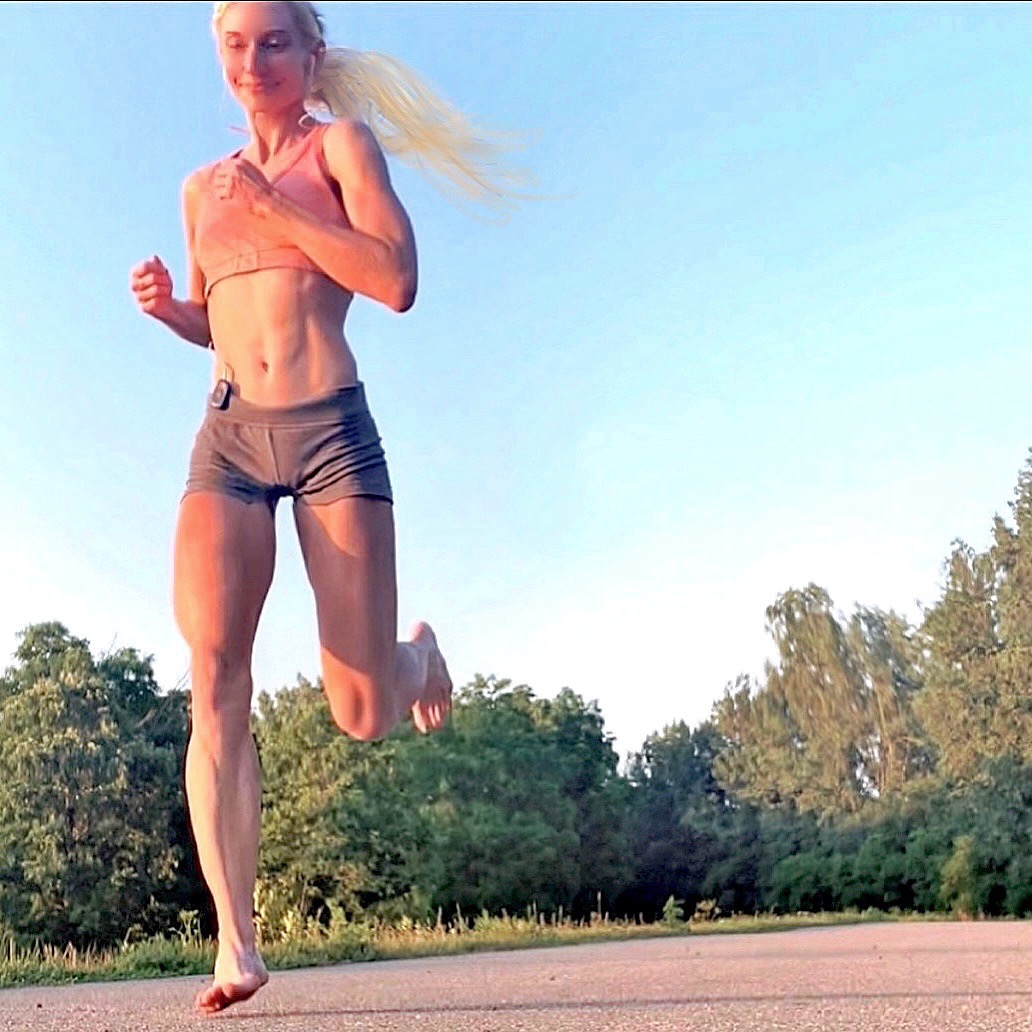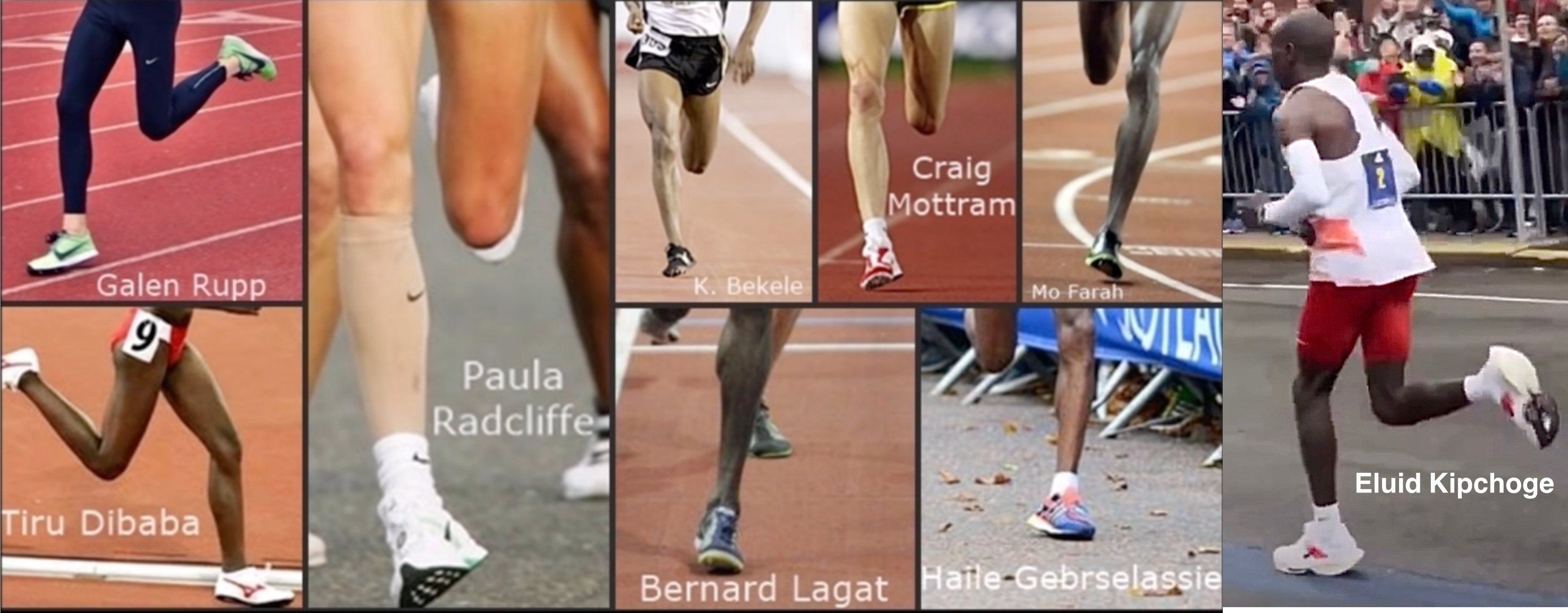The most recommended foot strike for not most, but ALL runners is a forefoot strike, not a heel strike!
A growing body of work, along with the fact that all short distance runners (100m -1500m) to the best long distance runners (5000m – marathon) are forefoot runners (shown below), and forefoot runners achieve more world records by a significantly larger multiple than heel strike runners, proves the correct foot strike for running is a forefoot strike.
Not to mention, after reading Born to Run by Christopher McDougall, and learning that humans evolved as endurance barefoot runners to hunt, I am convinced forefoot running is the proper way to run because think about it, if our ancestors ran barefoot fast, over long distances daily, they needed to employ a foot strike pattern that eliminated any chance of injury, otherwise extinction would have been eminent as our ancestors would have been too injured to run down pray, and therefore, starvation would have led to our demise.

Studies continue to pile up showing heel strike runners who suffer from foot, shin, knee, hip and back injuries have full resolve when they adopt the forefoot running technique, especially under barefoot and minimalist running conditions! In that regard, here are all the injuries caused by heel strike running that are prevented by forefoot running!
Below is a list of all the study-backed reasons forefoot running is the safest, most efficient running style, and why heel striking is the most damaging way to run:
The BEST For Injury Prevention – Forefoot running’s biggest claim to fame is it engages more functional mechanical outputs directly responsible for either preventing or reducing the injurious risk factors linked to heel strike running! Read more here!
The Most Functional Mechanics – Landing with a forefoot strike automatically engages additional mechanics responsible for either preventing or reducing all the risk factors that cause nearly all injuries linked to heel strike running! Read more here!
Stable, Safer Knees – Forefoot running’s big claim to fame is preventing knee injury by allowing the knee-joint to hold more stable, while being engaged in a more functionally useful manner to prevent over-striding and help absorb impact. Read more here!
Optimized Elastic Power In Achilles – Optimal running economy starts with enabling the Achilles tendon to function as an energy-saving spring to cut down on costly muscular efforts. Forefoot running is the only running style that reliably enhances spring loading in the Achilles, and that those increases in spring energy was found to enhance running economy vs heel strike running. Read more here!

Stronger Toes – Forefoot running offers more opportunity for the toes to strengthen because the toes are engaged in an entirely different, yet practical manner than in heel strike running. Read more here!
It’s Faster! – One of the many ways forefoot running is faster and more economical than heel strike running is it enhances the elastic power of the arch, while reducing impact severity on it, too! Read more here!
It’s Faster Pt2. – Landing on the forefoot when running makes it easier for the Achilles tendon to free up more elastic energy to put to work, since good running economy requires elto which is proven to help reduce expensive muscle costs.
It’s Faster Pt3. – Forefoot running enhances a specific stride parameter (stride angle) that helps reduce the time spent braking, which in turn, allows for more efficient accelerations as well as higher lactate thresholds than heel strike runners! Read more here!
No More Shin Splints – Forefoot running a day keeps the shin splints away by allowing for a more vertically aligned shin at landing, which was found to reduce the opposing forces responsible for shin splints as compared with heel strike running. Read more here!

Happier, Healthier Hips – Forefoot running sustains most optimal on the hips because forefoot striking engages key stride parameters that directly reduces stress off the hip, while loading more energy through the hip vs heel strike running. Read more here!
Proven Reasons Forefoot Running is Safer vs Heel Strike – Why forefoot runners worry less about getting injured than heel strikers. Read more here!
Lowest Impact, More Energy Pt.1 – Because all-around impact levels are significantly lower in forefoot running, less energy is needed for muscle tuning (the body’s natural shock attenuation mechanism). Read more here!
Lowest Impact, More Energy Pt. 2 – The low impact nature of forefoot running reduces joint loading, soft tissue movements and vibrational responses, all of which saves energy than heel strike running. Read more here!
Smoother Strides – Forefoot running produces more stride smoothness with less jerk at touchdown than heel strike running, and is why forefoot runners appear smoother and effortless, while heel strike runners appear choppy and rigid! Read more here!
Safer, More Functional Pronation – Forefoot running allows the foot to hold steady and controlled whereas heel strike running causes the foot to shift into extreme positions (over-pronation). Read more here!
More Spring Energy. Less Muscular Effort – Forefoot running reduces costly muscular demands by optimizing the spring properties of the arch and the Achilles tendon as compared with heel strike running. Read more here!
Better Stride Angle – Forefoot running is more energy efficient than heel strike running on account of engaging more efficient propulsions via a higher stride angle. Read more here!
Optimal Knee Mechanics – Forefoot runners were found to have more stable and functional knee-joint mechanics which helps reduce energy costs and impact. Read more here!
Stronger Toes – Forefoot running keeps the toes more actively engaged which helps keeps them functionally strong than heel strike running. Read more here!

Injuries Caused by Heel Strike Running That Are Preventing by Forefoot Running:
Patellofemoral Joint Stress – Patellofemoral joint stress is significantly higher in heel strike running, but is significantly reduced as soon as a heel strike runner switches to forefoot running. Read more here!
Hip Pain – Forefoot running reduces loading and impact on the hip-joint by preventing an over-stride, which is a stride metric only seen in heel strike running. Read more here!
Anterior Shin Splints – Landing heel-first when running requires the use of the front of the shin (anterior shin) to pull the forefoot back to heel strike. The repetitive forefoot-lifting at each step burns out the shins, causing anterior shin splints. In forefoot running, the forefoot does not need to lift up at landing because initial ground-contact is made on the forefoot, not the heel. This is why the anterior shin is not over-engaged and vulnerable to injury like it is in heel strike running. Read more here!
Runners Knee – There’s actually numerous ways heel striking when running damages the knee. One way is the prolong brake force at heel strike, which essentially causes the body to come to a crashing halt for a significantly longer period of time than forefoot running. Read more here!
Tibial Shock – Another reason forefoot running safeguards the shins from injury than heel strike running is by preventing opposing forces on the shin via improving the shins positioning at landing. Read more here!
Medial Calf Pain – Landing with a heel strike while running causes the calf muscles to over-stretch at a time where impact is higher than normal whereas when landing with a forefoot strike, the calves are not over-stretched and all-around impact levels are significantly lower. Read more here!
Tarsal Tunnel Syndrome – The prolonged brake period in heel strike running also causes compartment pressure to exceed tolerance along multiple sites in the lower leg and foot. Forefoot running was found to completely prevent this problem! Read more here!
Running Barefoot is the Fastest Way to Learn Forefoot Running!
Runners are most responsive in adopting the proper forefoot strike landing if they run barefoot because the direct contact of the bare foot with the ground is the most novel stimulus that helps the runner avoid heel strike while functionally strengthening the feet! In that light, here all the reasons why learning forefoot running by barefoot running matters more than cushioned running shoes:
Why Cushioned Running Shoes Keep Us Injured!
It’s a myth that the thicker the underfoot protection, the more safe we are from injury when running. This is a myth because the thicker the underfoot cushioning, the harder, more unstable and more mechanically reckless a runner is! Not to mention, the weaker and misshaped our feet become! Read more here!
For more in-depth insights on the health and performance benefits of forefoot strike running, check out my YouTube channel: here, where I also draw more attention to the advantages of barefoot running, especially its large role in making your forefoot running effectiveness more lucrative on many fronts.
References:
Warne JP, Warrington GD. Four-week habituation to simulated barefoot running improves running economy when compared with shod running. Scand J Med Sci Sports. 2014;24:563–8.
If you’d like, you can support Run Forefoot and help keep it going by making a donation in any amount of your choosing:

Or, you can support Run Forefoot by shopping at the BEST Barefoot Shoe Brands, and be sure to bookmark these links 🙂
Saguaro: https://www.saguaro.com/?ref=9bVA8fEkmDvB-I
Vibram FiveFingers: https://www.anrdoezrs.net/click-7600968-11372648
Vivobarefoot: https://amzn.to/3vycQOY
Be Lenka: https://www.dpbolvw.net/click-7600968-14330828
Xero Shoes: https://xeroshoes.com/go/Run_Forefoot
Iguaneye: https://www.iguaneye.com/?ref=8tfXVc92
Soft Star Shoes: https://shrsl.com/3mp1b
Wilding Shoes: https://bit.ly/3lIygQP
Bretta Riches
BSc Neurobiology; MSc Biomechanics candidate, ultra minimalist runner & founder of RunForefoot. I was a heel striker, always injured. I was inspired by the great Tirunesh Dibaba to try forefoot running. Now, I'm injury free. This is why I launched Run Forefoot, to advocate the health & performance benefits of forefoot running and to raise awareness on the dangers of heel striking, because the world needs to know.
Latest posts by Bretta Riches (see all)
- Heel Strike Running Causes Slipped Discs - 25/04/2024
- How to Train Yourself to Not Heel Strike When Running - 24/04/2024
- Cushioned Running Shoes Found to Be Bad for Ankles - 23/04/2024


